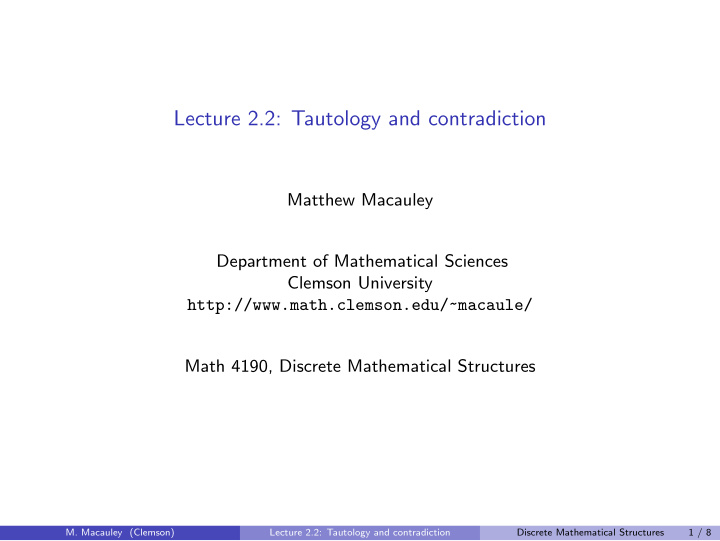



Lecture 2.2: Tautology and contradiction Matthew Macauley Department of Mathematical Sciences Clemson University http://www.math.clemson.edu/~macaule/ Math 4190, Discrete Mathematical Structures M. Macauley (Clemson) Lecture 2.2: Tautology and contradiction Discrete Mathematical Structures 1 / 8
Motivation Digital electronic circuits are made from large collections of logic gates, which are physical devices that implement Boolean functions. Figure: Image by user EICC on Vimeo, under a Creative Commons license. M. Macauley (Clemson) Lecture 2.2: Tautology and contradiction Discrete Mathematical Structures 2 / 8
Motivation Digital electronic circuits are made from large collections of logic gates, which are physical devices that implement Boolean functions. Figure: Image by user EICC on Vimeo, under a Creative Commons license. M. Macauley (Clemson) Lecture 2.2: Tautology and contradiction Discrete Mathematical Structures 3 / 8
Motivation Understanding digital circuits requires an understanding of Boolean logic. Recall that we have seen the following logical operations: p q p ∧ q p ∨ q p → q q → p ¬ q → ¬ p p ↔ q 0 0 0 0 1 1 1 1 0 1 0 1 1 0 1 0 1 0 0 1 0 1 0 0 1 1 1 1 1 1 1 1 Note that: p → q has the same truth table as ( ¬ p ∧ ¬ q ) ∨ ( ¬ p ∧ q ) ∨ ( p ∧ q ), or just ¬ p ∨ q . q → p has the same truth table as ( ¬ p ∧ ¬ q ) ∨ ( p ∧ ¬ q ) ∨ ( p ∧ q ), or just p ∨ ¬ q . p ↔ q has the same truth table as ( ¬ p ∧ ¬ q ) ∨ ( p ∧ q ). Not surprisingly, every Boolean function can be written with ∧ , ∨ , and ¬ . Even with just these operations, many propositions are the same. For example, ¬ ( p ∧ q ) and ¬ p ∨ ¬ q have the same meaning. M. Macauley (Clemson) Lecture 2.2: Tautology and contradiction Discrete Mathematical Structures 4 / 8
Compound propositions If p , q , and r are propositions, we say that the compound proposition c = ( p ∧ q ) ∨ ( ¬ q ∧ r ) is generated by p , q , and r . The value of c is determined by the 2 3 = 8 possibile combinations of truth values for p , q , and r . We can describe this via a truth table: p q r p ∧ q ¬ q ¬ q ∧ r ( p ∧ q ) ∨ ( ¬ q ∧ r ) 0 0 0 0 1 0 0 0 0 1 0 1 1 1 0 1 0 0 0 0 0 0 1 1 0 0 0 0 1 0 0 0 1 0 0 1 0 1 0 1 1 1 1 1 0 1 0 0 1 1 1 1 1 0 0 1 Note that the first three colums are the numbers 0 , . . . , 7 in binary. In general, if c is generated by n propositions, then its truth table will have 2 n rows. M. Macauley (Clemson) Lecture 2.2: Tautology and contradiction Discrete Mathematical Structures 5 / 8
Compound propositions Let S be any set of propositions. A proposition generated by S is any valid combination of propositions in S with conjunction, disjunction, and negation. Definition (formal) (a) If p ∈ S , then p is a proposition generated by S , and (b) If x and y are propositions generated by S , then so are ( x ), ¬ x , x ∨ y , and x ∧ y . There is a standard “order of operations”: 1. Negation: ¬ 2. Conjunction: ∧ 3. Disjunction: ∨ 4. Conditional operation: → 5. Biconditional operation: ↔ Despite this, we will avoid writing potentially ambiguous statements like p ∨ q ∧ r . Expressions like the following should be unambiguous: (a) p ∧ q ∧ r is ( p ∧ q ) ∧ r (b) ¬ p ∨ ¬ r is ( ¬ p ) ∨ ( ¬ r ) (c) ¬¬ p is ¬ ( ¬ p ). M. Macauley (Clemson) Lecture 2.2: Tautology and contradiction Discrete Mathematical Structures 6 / 8
Tautologies Definition An expression involving logical variables that is true in all cases is a tautology. We use the number 1 to symbolize a tautology. Examples The following are all tautologies: (a) ( ¬ ( p ∧ q )) ↔ ( ¬ p ∨ ¬ q ) (b) p ∨ ¬ p (c) ( p ∧ q ) → p (d) q → ( p ∨ q ) (e) ( p ∨ q ) ↔ ( q ∨ p ) M. Macauley (Clemson) Lecture 2.2: Tautology and contradiction Discrete Mathematical Structures 7 / 8
Contradictions Definition An expression involving logical variables that is false in all cases is a contradiction. We use the number 0 to symbolize a contradiction. Examples The following are contradictions: (a) p ∧ ¬ p (b) ( p ∨ q ) ∧ ( ¬ p ) ∧ ( ¬ q ) M. Macauley (Clemson) Lecture 2.2: Tautology and contradiction Discrete Mathematical Structures 8 / 8
Recommend
More recommend